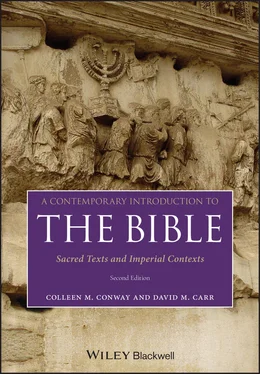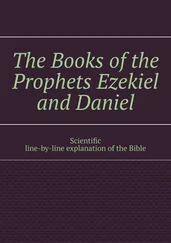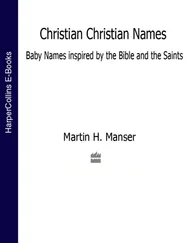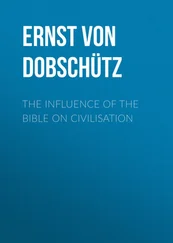1 ...7 8 9 11 12 13 ...24
Bible Abbreviations, Chapters and Verses
When books and articles cite biblical passages by chapter and verse, they usually follow this order: abbreviation for the biblical book, followed by the chapter number, a colon (:), followed by the verse. An example is Isa 44:28 (chapter 44, verse 28). If more than one verse is cited, dashes and commas can be used: Isa 44:20, 28 or Isa 44:10–13, 28. When scholars want to refer to the bulk of a passage without detailing specific verses left out, they will add an asterisk to indicate that some verses are not meant to be included in the reference, e.g. Genesis 28*. Occasionally, you will also see scholars refer to half-verses, e.g. 2:4a or 2:4b, following accent divisions found in their Hebrew Bibles. Such notations will be used in this book only to label citations that begin or end in a half-verse.
Here are some standard abbreviations for biblical books shared by Jewish and Christian Bibles (given in the order followed by most Christian Bibles). Sometimes these are further shortened by just giving the first two letters (e.g. Ex instead of Exod) or removing a vowel (e.g. Jdg for Judges):
| Gen = Genesis |
Esther = Esther |
Hos = Hosea |
| Exod = Exodus |
Job = Job |
Joel = Joel |
| Lev = Leviticus |
Ps or Pss = Psalms |
Amos = Amos |
| Num = Numbers |
Prov = Proverbs |
Ob = Obadiah |
| Deut = Deuteronomy |
Eccl = Ecclesiastes |
Jon = Jonah |
| Josh = Joshua |
Song = Song of Songs |
Micah = Micah |
| Judg = Judges |
(also known as Canticles, |
Nah = Nahum |
| Ruth = Ruth |
and Song of Solomon) |
Hab = Habakkuk |
| Sam = Samuel |
Isa = Isaiah |
Zeph = Zephaniah |
| Kgs = Kings |
Jer = Jeremiah |
Hag = Haggai |
| Chr = Chronicles |
Lam = Lamentations |
Zech = Zechariah |
| Ezra = Ezra |
Ezek = Ezekiel |
|
| Neh = Nehemiah |
Dan = Daniel |
|
Here are the abbreviations for books in the New Testament:
| Matt = Matthew |
Eph = Ephesians |
Heb = Hebrews |
| Mark = Mark |
Phil = Philippians |
Jas = James |
| Luke = Luke |
Col = Colossians |
1–2 Pet = 1–2 Peter |
| John = John |
1–2 Thess = 1–2 |
1–2–3 John = 1–2–3 John |
| Acts = Acts |
Thessalonians |
Jude = Jude |
| Rom = Romans |
1–2 Tim = 1–2 Timothy |
Rev = Revelation |
| 1–2 Cor = 1–2 Corinthians |
Titus = Titus |
|
| Gal = Galatians |
Phlm = Philemon |
|
The Origins of Chapters and Verses
The earliest Hebrew and Greek manuscripts of the Bible lack any chapter or verse numbering (see Figure 0.2). The Hebrew Bible was divided into sections for reading in the synagogue, and the Greek New Testament was divided into sections as well, but there were no numbers in these early manuscripts.
Verse divisions were first added into the Hebrew Bible (without numbers) by the Masoretes, a group of Jewish scholars who worked in the seventh to tenth centuries CE and produced the standard edition of the Hebrew Bible now used in Judaism. The chapter divisions we now have were developed in 1205 by Stephen Langton, a professor in Paris and eventually an archbishop of the Church of England. He introduced them into his edition of the Latin Vulgate translation of the Bible, and these divisions were later adopted by Jewish scholars as they became popular means to refer to biblical passages.
The first Old Testament and New Testament Bible with numbered verses was produced in 1555 by a Parisian book seller, Robert Estienne (also known as Stephanus). He is reported to have divided a copy of his New Testament into the present 7,959 verses while riding on horseback from Paris to Lyon. He also numbered the chapters and verses of both the Old and New Testament. Now these verses are found in scholarly editions of the Hebrew Bible (see Figure 0.1 on p. 8) and in translations of the Bible.
Conclusion on Critically Analyzing a Page of Your Own Bible
This chapter just starts to indicate how every page of your Bible, whether a Jewish Tanakh or a particular Christian Bible, is the product of an intense process of textual criticism, analysis of the original language of biblical passages, and packaging of the particular translation of such passages through elements like chapter and verse numbers. Ancient manuscripts were often divided into longer, unnumbered reading sections (for use in worship and study), and they sometimes included marginal comments or additional verses here or there (see Figure 0.2 below). Nevertheless, they did not have the numbering, headings, or reader guides now in the Bible before you. Take note of every element on a given page of your contemporary Bible that helps frame the biblical text and present it to you. Your first step as a critical reader of the Bible is become more conscious of these elements and more familiar with their characteristics.
1 Know the meaning and significance of the following terms discussed in this chapter:apocryphacanon and canonicalconjectural emendationdeuterocanonical booksdynamic equivalence translationformal correspondence translationHebrew BibleKing James VersionLXXmanuscript witnessMasoretic text (MT)Old TestamentQur’anPentateuchSeptuagintsupersessionismTanakh or TaNaKtextual criticismTorah
2 What are the main differences between the Christian Old Testament and the Jewish Tanakh?
3 How is the Islamic Qur’an related to the Jewish and Christian Bibles?
RESOURCES FOR FURTHER STUDY
Editions of Translations
1 The New Jerusalem Bible. New York: Doubleday, 1985. This is the NJB.
2 The New Oxford Annotated Bible with Apocrypha (5th edition), eds. Michael Coogan et al. New York: Oxford University Press, 2018. This contains the NRSV.
3 The Jewish Study Bible, eds. A. Berlin et al. New York: Oxford University Press, 2004. This contains the NJPS.
4 The HarperCollins Study Bible (fully revised and updated), eds. Harold W. Attridge et al. San Francisco, CA: Harper-SanFrancisco, 2006. This contains the NRSV.
One-Volume Commentaries
1 Mays, James L., ed. HarperCollin’s Bible Commentary (revised edition). San Francisco, CA: Harper & Row, 2000.
2 Newsom, Carol A., and Ringe, Sharon H. The Women’s Bible Commentary (3rd edition). Louisville, KY: Westminster John Knox Press, 2012.
Technological Resources
1 Bible Software: Accordance Bible Software. It is recommended that you purchase the NRSV, NJB, or other up-to-date translation. As of the writing of this Introduction, you are given the King James Version (outdated for academic study of the Bible) as part of the initial package.
2 You can also obtain free software for searching and reading the Bible at www.crosswire.org.
Useful Websites for Translation Comparison
1 The Bible Gateway (mostly Christian translations) – www.biblegateway.com
2 Bible Study Tools (mostly Christian translations) – https://www.biblestudytools.com/compare-translations
3 Sefaria (access to the New Jewish Publication Society version and other Jewish texts) – www.sefaria.org
APPENDIX 1: TRANSLATION AND PARAPHRASE COMPARISON OF ISA 52:13–15
| Isaiah Chapter and Verse |
Revised Standard Version |
New American Standard Version |
New International Version |
Today’s English Version (Good News Bible) |
| 52:13 |
Behold my servant shall prosper, he shall be exalted and lifted up, and shall be very high. |
Behold my servant will prosper, He will be high and lifted up, and greatly exalted. |
See, my servant will act wisely; he will be raised and lifted up and highly exalted. |
The Lord says, My servant will succeed in his task; he will be highly honored. |
| 52:14 |
As many were astonished at him – his appearance was so marred, beyond human semblance, and his form beyond that of the sons of men – |
Just as many were astonished at you, My People , so His appearance was marred more than any man, And his form more than the sons of men. |
Just as there were many who were appalled at him – his appearance was so disfigured beyond that of any man and his form marred beyond human likeness – |
Many people were shocked when they saw him; he was so disfigured that he hardly looked human. |
| 52:15 |
so shall he startle many nations; kings shall shut their mouths because of him; |
Thus he will sprinkle many nations, Kings will shut their mouths on account of Him; |
so will he sprinkle many nations, and kings will shut their mouths because of him. |
But now many nations will marvel at him, and kings will be speechless with amazement. |
| for that which has not been told them they shall see, and that which they have not heard they shall understand. |
For what had not been told them they will see, And what they had not heard they will understand. |
For what they were not told, they will see, and what they have not heard, they will understand. |
They will see and understand something they had never known. |
| 52:13 |
Behold, my servant shall prosper, he shall be lifted up, exalted to the heights. |
See, my Servant shall prosper; he shall be highly exalted. |
Indeed, My servant shall prosper, be exalted and raised to great heights. |
Look, my servant will prosper, will grow great, will rise to great heights. |
| 52:14 |
Time was when many were aghast at you, my people; |
Yet many shall be amazed when they see him – yes, even far-off foreign nations and their kings; (See the end of 52:15 for the rest) |
Just as the many were appalled at him – So marred was his appearance, unlike that of man, His form, beyond human semblance – |
As many people were aghast at him – he was so inhumanly disfigured that he no longer looked like a man – |
| 52:15 |
… so now many nations recoil at the sight of him, and kings curl their lips in disgust. For they see what they had never been told and things unheard before fill their thoughts. |
… they shall stand dumbfounded, speechless in his presence. For they shall see and understand what they had not been told before. They shall see my Servant beaten and bloodied, so disfigured one would scarcely know it was a person standing there. So shall he cleanse many nations. |
Just so he shall startle many nations. Kings shall be silenced because of him, For they shall see what has not been told them, Shall behold what they never have heard. |
so many nations will be astonished and kings will stay tightlipped before him, seeing what had never been told them, learning what they had not heard before. |
APPENDIX 2: CHARACTERISTICS OF SELECT ENGLISH TRANSLATIONS OF THE BIBLE
Читать дальше












